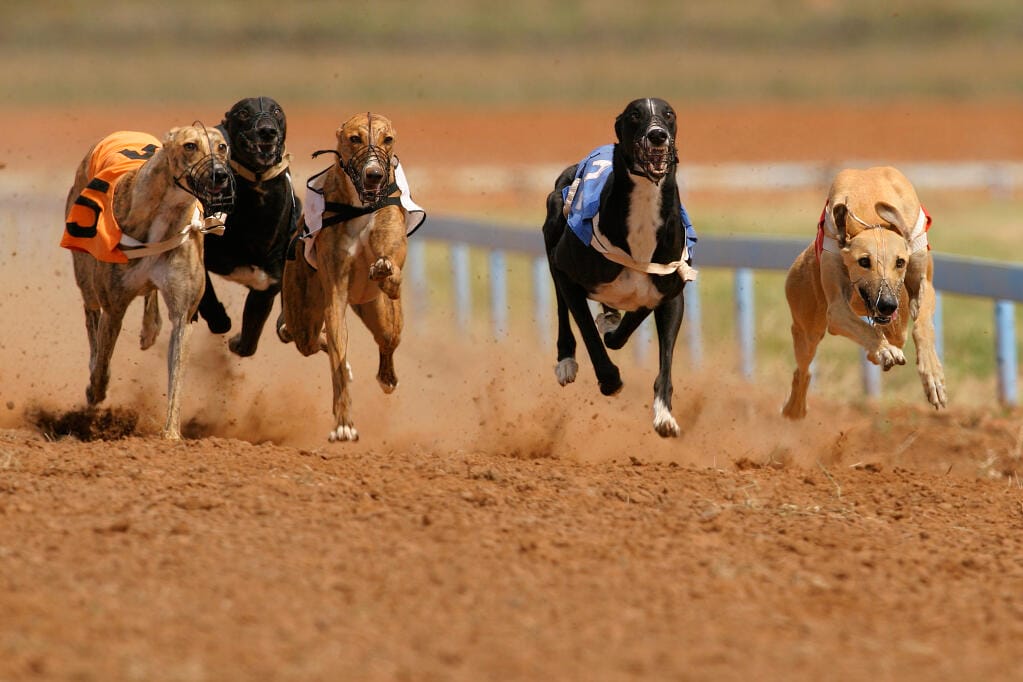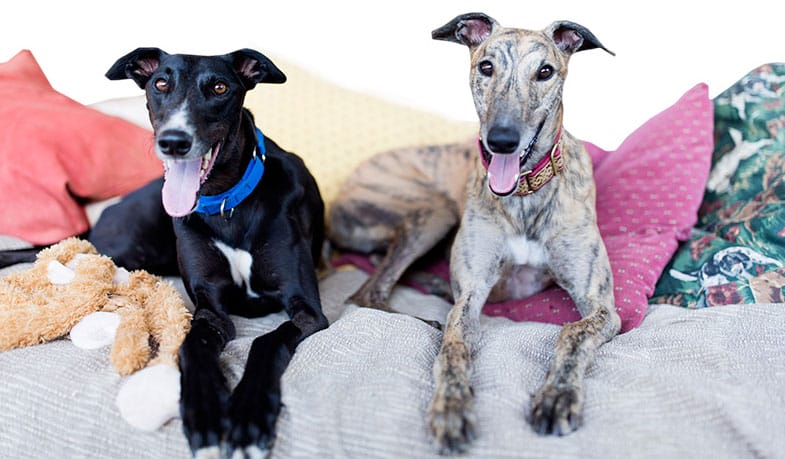Renowned for their athleticism and acute sight, the Greyhound has been a favourite in Britain since the Middle Ages. A law passed at this time stated that only royalty and nobility could hunt with the prestigious dogs.
Intelligent, affectionate and calm, these low maintenance dogs are happy to spend their day relaxing with their human families. They are best suited to owners who understand the unique needs of Greyhounds.

I. Introduction about Greyhound Dog Breed
Greyhounds are a well-known breed that is known for how fast and graceful they are.
In this section, we’ll talk briefly about Greyhounds and try to figure out why dog lovers like them so much.
Reasons why they are such a popular breed:
There are a few reasons why greyhounds are popular:
•Speed and grace: Greyhounds are known for how fast and graceful they are. They can run up to 45 miles per hour (72 km/h), making them one of the fastest dog breeds. Their smooth, athletic bodies and the way they run with no effort make them very interesting to watch.
•Gentle and loving: Despite how good they are at sports, They have a gentle and loving personality. People say they are loving and calm, and they are often called “45-mile-per-hour couch potatoes.” They need people to be happy, and they have strong bonds with their families.
•Good with Kids: They are usually kind and patient with kids, which makes them good pets for a family. They are good pets for homes with kids because they are calm and can adjust to different environments.
•Low Need for Exercise: They are very fast, but they don’t need a lot of exercise. They have bursts of energy when they play or run short distances, but they don’t need a lot of exercise otherwise. They are great pets for people or families who want a breed with less energy and more calmness.
•Greyhounds don’t need much grooming because their short, smooth coats don’t need much care. They don’t have an undercoat, so they don’t shed much, and most people think of them as an easy-care breed when it comes to grooming.
II. History
Origins of the breed:
The Greyhound breed is very old and is thought to have been around for more than 4,000 years.
They are one of the oldest purebred dog breeds, and people have always liked them because they are good at hunting and running.
Greyhounds were first bred for their speed and agility, and their ability to chase and catch prey like deer and hares made them very valuable.
Differences between Greyhounds and other breeds:
Greyhounds are different in several ways from other dog breeds:
1.Greyhounds have long, skinny legs and a deep chest. Their bodies are lean and muscular. The shape of their bodies and the strength of their back legs help them move very quickly.
2.While many dog breeds have been made to do specific jobs, Greyhounds have a long history of being hunted and raced. They were mostly raised to be fast and able to catch their prey.
3.Greyhounds are known for having a gentle and calm personality. Greyhounds are usually friendly and not aggressive, unlike some breeds that were made to guard or protect.
III. Characteristics
Physical appearance:
Greyhounds look different from other dogs:
They have slim, muscular bodies with a deep chest, narrow waists, and long, graceful necks.
Long, skinny legs: Their long legs help them move quickly and move around quickly.
Greyhounds are sighthounds, so they have slim head, sharp eyes, and ears that can be folded back or stand up halfway.
Personality traits:
Greyhounds have traits that make them different:
They are known for being gentle and loving, which is why they are often called “velcro dogs” because they like to be with people.
Calm and quiet: In general, they are calm and quiet dogs. They are not known to bark a lot, and most of the time they are happy to be in a quiet place.
Greyhounds are usually friendly, but they can be reserved with people they don’t know. Getting to know people the right way from a young age can help them feel more at ease in different situations.
Size:
Males are between 26 and 30 inches (66 to 76 cm).
Females are between 24 and 28 inches (61 to 71 cm).
Greyhounds are a breed that ranges from medium to large.
Weight:
The male is between 65 and 85 pounds (29 to 39 kg).
Female is between 60 and 70 pounds (27 to 32 kg).
Greyhounds can be of different sizes and shapes, which can change how much they weigh.
Lifespan:
About 10 to 14 years.
But if they get good care, eat well, and go to the vet regularly, they can live even longer and stay healthy.

IV. Training and socialization
Importance of early training and socialization:
Greyhounds need early training and socialization to grow up to be well-rounded and well-behaved dogs.
It helps them get used to new places, improves their ability to get along with other dogs and people, and builds a strong bond with their owners.
Recommended training methods:
Greyhounds learn best from training methods that give them rewards. With these methods, they get treats, praise, or playtime when they do something good, which makes them more likely to do it again.
Greyhounds do well when they are trained with gentle guidance and consistency. They are sensitive dogs that are easily put off by training methods that are harsh or mean.
Common behavioral issues and how to address them:
Greyhounds often have problems with their behavior, like being afraid of being alone or being sensitive to sudden noises or movements. Here are some ways to deal with these problems:
Separation anxiety: Gradual desensitization, crate training, and providing mental stimulation with interactive toys or puzzles can help.
Shyness: Exposing them slowly to new places, people, and things while giving them positive feedback can help them gain confidence.
Counterconditioning techniques, like gradually exposing them to the sounds and pairing them with good things, can help them become less sensitive to sudden noises.
V. Maintenance and care
Common diseases and symptoms:
Like all dog breeds, they can be prone to certain health problems. Some of the most common health problems seen in Greyhounds are:
Bloat, or Gastric Dilatation Volvulus, is a condition in which the stomach twists, which can be life-threatening. Symptoms include restlessness, trying to throw up but not being able to, a swollen stomach, and signs of distress. If bloat is suspected, it is very important to get help from a vet right away.
Hypothyroidism is a condition that happens when the thyroid gland doesn’t work as well as it should. It can cause weight gain, hair loss, feeling tired, and skin problems. Regular testing of thyroid function can help find and treat this condition.
Osteosarcoma is a type of bone cancer that is more common in greyhounds than in other dogs. Early diagnosis and the right kind of treatment can help the prognosis.
Problems with the teeth: Greyhounds can have dental problems, like periodontal disease. To keep their oral health in good shape, they need to brush their teeth and go to the dentist regularly.
Dietary needs:
For the health and well-being of Greyhounds, it is important to feed them a healthy, balanced diet.
Most of the time, it’s best to feed them high-quality commercial dog food that meets their nutritional needs.
The amount they eat should match their age, size, level of activity, and any special dietary needs or restrictions.
Talk to your vet about what your Greyhound should eat.
Exercise requirements:
Even though Greyhounds are known for how fast they are, they don’t need a lot of exercise. They are sprinters and like to do a lot in short bursts.
Most of the time, a daily walk and a few chances to run or play in a safe enclosed area are enough to meet their exercise needs.
But it’s important to remember that Greyhounds have a strong drive to hunt, so they should always be walked on a leash or exercised in a safe area.
Grooming and hygiene:
Greyhounds have short, smooth coats that don’t need much care. They don’t have an undercoat, so they don’t shed much.
Using a soft-bristled brush or grooming mitt to brush them regularly will help remove loose hair and keep their coat healthy.
They don’t smell too bad most of the time, and you only need to bathe them when they get dirty or smell bad.
It is important to check their ears, trim their nails, and keep their teeth clean on a regular basis.
Breeding and reproduction:
When Greyhounds are bred, the health and happiness of the breed should come first.
Responsible breeders focus on making puppies that have good personalities, and healthy bodies, and follow breed standards. They check the health of the parent dogs to reduce the chance that they will pass on health problems.
It’s important to work with reputable breeders who put the health and happiness of their dogs first, provide the right paperwork, and help out people who buy puppies from them.

Where to buy or adopt:
Consider the following if you want to buy or adopt a Greyhound:
Greyhound Adoption Groups: There are many adoption groups and rescue groups whose goal is to find loving homes for Greyhounds that used to race but no longer do so. These groups give people the chance to adopt them in need, and they often help adopters with support and advice.
Reputable Breeders: If you decide to buy from a breeder, you should do your research and look for breeders who put the health and happiness of their dogs first. They should check the health of the parent dogs, provide the right paperwork, and keep in touch with puppy buyers.
Check with local animal shelters and rescue centers to see if they have available for adoption. Adopting a Greyhound from a shelter not only gives them a second chance at a loving home, but also makes room for other dogs who need homes.
VI. Greyhounds in popular culture
Famous Greyhounds:
Even though individual Greyhounds may not be as well known as some other breeds, they as a breed has been in films, TV shows, and books.
Their unique look and historical importance have helped them become a part of popular culture.
Use of Greyhound in film and television:
Greyhounds have been in movies and TV shows, and they are usually portrayed as elegant and regal characters.
They are sometimes portrayed as trustworthy friends, smart working dogs, or even fictionalized versions with special skills.
Representation of the breed in media:
Greyhounds have been pictured in books and paintings for a long time.
Because of how sleek and elegant they look and how they are related to royalty and nobility, they have been the subject of admiration and inspiration in many forms of media.
VII. Conclusion
In conclusion, Greyhounds are a popular breed known for their speed, elegance, and gentleness. People and families who like their unique qualities will find them to be great companions.
Greyhounds have a long history, are very athletic, and don’t need much grooming. But you should think about how sensitive they are and how they might affect your health.
The health and happiness of this amazing breed depend on how it is bred, how it is trained, and how it is cared for.
More information about Dog Breeds & Dog Care follow Dog Care Tips site.

